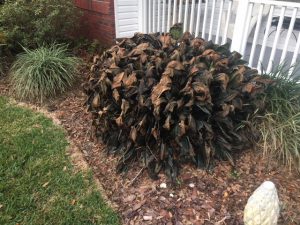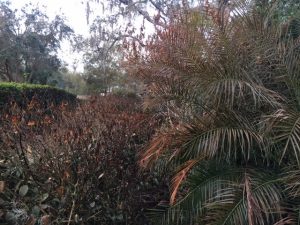While central Florida offers year-round gardening, it is not unusual for brief, but devastating cold temperatures to occur in the months of January and February. These brief periods can be very frustrating as we witness plant damage from brutal temperatures. Here are a few tips on how to help protect your plants from cold damage before, during, and after frost or freezing temperatures.

BEFORE: PLAN AHEAD
When selecting plants for your landscape, select mostly cold hardy varieties, either Florida native plants or non-native Florida-Friendly selections appropriate for our hardiness zone, which is 9b. (The USDA Hardiness Zone Map divides North America into 11 separate planting zones; each growing zone is 10°F warmer (or colder) in an average winter than the adjacent zone.)
Include evergreen plants as well as flowering, so if a hard freeze occurs, your hardy evergreens will stand out beautifully, while cold-damaged plants recover.
Avoid pruning landscape plants in the fall, as pruning will produce tender new growth which is more susceptible to cold damage.
If you have plants that you anticipate covering for protection, stock up on lightweight covers during the year (e.g., inexpensive sheets at garage sales, commercial frost-protection sheets, etc.).
Maintain a 2-3” layer of organic mulch in your plant beds, as mulch moderates soil temperatures.
If you have tropical cold-tender plants in your landscape, consider the following ways to decrease cold damage: (These would be plants rated for hardiness zone 10 or higher.)
- Install cold-tender plants on the south/southeast side of buildings.
- Install shade tolerant tender plants below tree canopies, as tree canopies provide a protecting micro-climate.
- Avoid planting cold-tender plants in low places of your yard (cold air settles in low spots of the landscape).
- Avoid planting cold-tender plants in areas of poor drainage.
- Consider planting cold-tender tropical plants in containers, which can be brought inside during cold weather.
WHEN COLD TEMPERATURES ARE PREDICTED
Specimen plants can be covered with protective covers including sheets and lightweight blankets. Coverings should be removed or at least ventilated as temperatures rise during the day. For best protection, coverings must touch the ground completely; commercial covers work well, as they can be purchased in large sizes.

Remember that covering plants will offer protection from frost damage more than from damage due to actual freezing temperatures. For extra protection from freezing temperature, you can construct a makeshift “greenhouse”. Create a frame around your plant from wooden posts or pvc pipes, and cover with protective cloth; place a heat bulb inside for extra warmth. (In the past, Christmas lights were ideal for this plan. Newer “cool” bulbs won’t add warmth.)
On the day of an expected freeze, water in-ground plants. Moist soil will absorb more heat than dry soil and can slightly raise soil temperature.
Turn off automatic irrigation during freezing temperatures.
Place pine straw or hay against the plant center of favorite plants (remember to remove after freezing temperatures). If you have a grafted tree or shrub, wrap the trunk with a blanket to protect the grafted area.
Bring container plants inside to a garage or porch. Group multiple containers together against an east/southeast wall. Create a “lean-to” with tarps to cover and place a heat bulb inside.
AFTER THE FREEZE
Cold temperatures accompanied by wind can dry plant tissues. Water plants on the day after a freeze to replenish needed moisture.
To prune or not to prune? Generally, it is recommended not to prune cold damaged stems or branches until the possibility of freezing temperatures has ended for the winter. Unsightly dead blooms or foliage can be removed. The reason to delay complete pruning is that in our inevitable days of warmth following a freeze, pruning can encourage new tender growth. If we experience subsequent freezes, this new growth can be damaged, resulting in more injury to an already stressed plant. While it is very frustrating to live with brown, damaged plants when the weather is balmy and sunny, it may help to remember that those unattractive brown and wilted stems help protect the plant parts below the damaged areas.
Pruning can be resumed in the spring (around early March). To learn the extent of damage, scratch the surface of woody stems until you see green, which indicates healthy plant tissue. Prune just past this point.
Visit this website for more information on protection of plants from cold damage.
DID YOU KNOW?
Frost occurs when water vapor freezes on plant surfaces, usually on clear nights with still air. Frost can occur when temperatures are above freezing (32 degrees F).
A freeze occurs when the air temperature reaches below 32 degrees F. Freezing is often associated with low humidity, and wind which damages plants through the drying of plant tissues (desiccation).
A hard freeze occurs when air temperature reaches below 28 degrees F.
This blog post was written by Master Gardener Molly Griner under supervision of the Master Gardener Coordinator and Residential Horticulture Agent Anne Yasalonis.
For more information, contact UF/IFAS Extension Polk County at (863) 519-1041 or visit us online at http://sfyl.ifas.ufl.edu/polk. The Plant Clinic is open Monday-Friday, 9:00 am-4:00 pm to answer your gardening and landscaping questions. Visit us in person, give us a call, or email us at polkmg@ifas.ufl.edu.
The Florida Master Gardener Program is a volunteer-driven program that benefits UF/IFAS Extension and the citizens of Florida. The program extends the vision of the University of Florida/Institute of Food and Agricultural Sciences, all the while protecting and sustaining natural resources and environmental systems, enhancing the development of human resources, and improving the quality of human life through the development of knowledge in agricultural, human and natural resources and making that knowledge accessible.
An Equal Opportunity Institution.
 0
0
